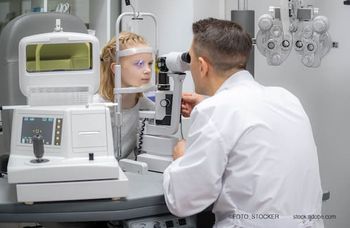
Tech upgrades can reveal early structural damage of retina
Upgrades to specific confocal laser scanning systems (Heidelberg Retina Tomograph [HRT] and Heidelberg Retina Angiograph 2 [HRA 2], Heidelberg Engineering) should increase the utility of the devices, according to two physicians who have evaluated the new technology.
One system (HRT), which uses scanning laser ophthalmoscopic technology to image the surface of the retina, traditionally has been used as a technology to measure the optic disc in glaucoma management. With a new retina or macula model, clinicians also can use the technology to detect conditions such as age-related macular degeneration (AMD), diabetic macular edema, and cystoid macular edema, said Scott Cousins, MD, the Robert Machemer Professor of Ophthalmology, Duke University Eye Center, Durham, NC.
"The macular module is meant to be an alternative technology to optical coherence tomography [OCT] for imaging the macula," Dr. Cousins said.
Dr. Cousins has tested the retina module for the company in the context of a tool for general ophthalmologists who have the system for optic nerve detection and might opt to buy a new module for the early detection of referable or treatable macular disease rather than invest in an OCT system. "I've not looked at it as a tool for the retina doctor to supplement OCT," Dr. Cousins said.
"The bottom line is that if you compare the [confocal laser scanning system] map with the OCT map of macular contour, they're roughly comparable in sensitivity and specificity. In fact, it may be that the [confocal laser scanning system] is a little bit more sensitive in picking up disease that the OCT map might miss, for both diabetes and AMD," Dr. Cousins said.
The module may be sensitive enough that it picks up warning signs of diabetic changes before they become clinically manifest, Dr. Cousins said. "There's some evidence that abnormalities on the edema map might pick up eyes that haven't yet reached the threshold for needing laser treatment but are destined to reach that threshold in the course of the next year.
"From my point of view, it's a reasonable alternative for the general ophthalmologist as a device for detection of treatable or referable macular disease," he added.
Viewing the macula
The new retina module is a noninvasive way of looking at the topography and the thickness of the macula, said William R. Freeman, MD, professor and director of the Jacobs Retina Center, Shiley Eye Center, University of California, San Diego. Dr. Freeman has conducted studies comparing the module with OCT, which most retina specialists consider the gold standard.
OCT takes a small number of cuts across the macula, looks at the cross-section of those sections, and interpolates all of the information in between the segments to produce a macular thickness map, Dr. Freeman said. Although this technique is very precise, he said, the disadvantage is that it looks at only a small percent of the retina, sampling less than 10%, and interpolates the rest of the data.
In contrast, the confocal laser scanning system software reviews thousands of spots over the retina, measuring each by confocal microscopy. The result is less precise than that of OCT, but many more locations are measured, Dr. Freeman said. "You're sampling almost every point on the retina instead of only 5% to 10%."
Newsletter
Don’t miss out—get Ophthalmology Times updates on the latest clinical advancements and expert interviews, straight to your inbox.



















































.png)


